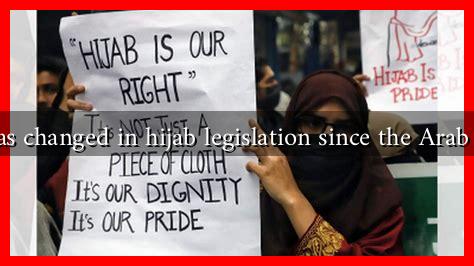-
Table of Contents
- What Has Changed in Hijab Legislation Since the Arab Spring?
- The Context of the Arab Spring
- Case Studies: Changes in Hijab Legislation
- Tunisia: A Model of Secularism
- Egypt: A Complex Landscape
- Iran: The Continuation of Mandatory Hijab
- Statistics and Public Opinion
- Conclusion: The Future of Hijab Legislation
What Has Changed in Hijab Legislation Since the Arab Spring?
The Arab Spring, a series of anti-government protests and uprisings that swept across the Arab world starting in late 2010, has had profound implications for various aspects of society, including women’s rights and religious expression. One of the most visible symbols of these changes is the hijab, a traditional headscarf worn by many Muslim women. This article explores the evolution of hijab legislation in several key countries since the Arab Spring, highlighting the shifts in societal attitudes, legal frameworks, and the implications for women’s rights.
The Context of the Arab Spring
The Arab Spring was characterized by demands for democracy, social justice, and human rights. In many countries, these movements led to the overthrow of long-standing regimes, creating a power vacuum that allowed for the re-examination of cultural and religious practices, including the hijab. The aftermath of these uprisings has seen varying degrees of change in hijab legislation across the region.
Case Studies: Changes in Hijab Legislation
Tunisia: A Model of Secularism
Tunisia is often cited as a success story of the Arab Spring. After the ousting of President Zine El Abidine Ben Ali in 2011, the country adopted a new constitution in 2014 that enshrined women’s rights and gender equality. The Tunisian government has maintained a secular stance, allowing women the freedom to choose whether or not to wear the hijab.
- In 2017, the Tunisian Minister of Education announced that wearing the hijab would not be a barrier to employment in public schools.
- Women have increasingly participated in public life, with many choosing to wear the hijab as a personal expression of faith rather than a political statement.
Egypt: A Complex Landscape
In Egypt, the situation is more complex. Following the 2011 revolution, the Muslim Brotherhood came to power, leading to a brief period where the hijab was more widely accepted. However, the military coup in 2013 resulted in a crackdown on Islamist groups, and the hijab became a contentious symbol of political identity.
- In 2014, the Egyptian government issued a decree allowing women to wear the hijab in public institutions, but this was often met with societal pushback.
- Public discourse around the hijab has been polarized, with some viewing it as a symbol of oppression while others see it as an expression of personal freedom.
Iran: The Continuation of Mandatory Hijab
In Iran, the hijab has been mandatory since the 1979 Islamic Revolution. The Arab Spring did not lead to any significant changes in this legislation. However, the protests that erupted in 2019 and again in 2022 over various social issues, including women’s rights, have reignited discussions about the hijab.
- In 2022, widespread protests against the death of Mahsa Amini, who was arrested for not wearing her hijab properly, highlighted the growing discontent with mandatory hijab laws.
- The Iranian government has faced increasing pressure from both domestic and international communities to reconsider its stance on women’s dress codes.
Statistics and Public Opinion
Public opinion on hijab legislation varies significantly across the region. A 2021 survey by the Arab Barometer found that:
- In Tunisia, 62% of respondents supported the right of women to choose whether to wear the hijab.
- In Egypt, 45% believed that the hijab should be a personal choice, while 30% supported its mandatory use.
- In Iran, 70% of women expressed dissatisfaction with the mandatory hijab laws, indicating a desire for change.
Conclusion: The Future of Hijab Legislation
The Arab Spring has undeniably influenced hijab legislation across the region, leading to a complex interplay of cultural, political, and religious factors. While some countries like Tunisia have embraced a more secular approach, others like Iran continue to enforce strict regulations. The ongoing debates surrounding the hijab reflect broader societal changes and the struggle for women’s rights in the Arab world.
As the region continues to evolve, the future of hijab legislation will likely depend on the balance between tradition and modernity, individual rights, and collective identity. The voices of women will be crucial in shaping this discourse, as they navigate their rights and freedoms in a rapidly changing landscape.
For further reading on women’s rights in the Arab world, you can visit Human Rights Watch.

